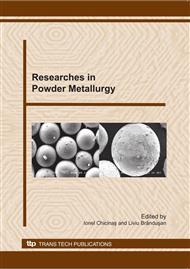p.245
p.251
p.255
p.259
p.263
p.271
p.276
p.281
p.289
A Study on the Effect of Manufacturing Conditions on Surface Roughness during Machining of Cu/Al2O3 Composites
Abstract:
In this study, the machinability of the Cu matrix composites reinforced with 5, 10, 15 and 20 vol.% of Al2O3 particulates produced by powder metallurgy have been investigated. The effects of compaction pressure, sintering duration and volume fraction of reinforcing component on the surface roughness during machining of the considered composites, obtained by the appropriate Cu-Al2O3 powder mixtures cool die pressing at 500, respectively 700 MPa, and sintered at 800 °C for durations of 45 and 60 minutes in an argon atmosphere were determined. The machining tests were performed on a CNC machining centre, by means of samples face milling in dry conditions, at two different feed rates and four different cutting speeds, while the depth of cut was kept constant. As cutting tools have been adopted commercial grade (H13A) uncoated cemented carbide inserts manufactured by Sandvik Coromant with the geometry of TPKN1603 PP-R. After the machining tests, the surface roughness measurements clearly showed an increasing trend in surface roughness when the feed rate is increased from 300 mm/min to 400 mm/min for both sintering durations. Surface damages created on the machined surface through release from the matrix of particles negatively impact surface roughness. The most stable results in terms of surface roughness were obtained at 20% reinforcing ratio for 700 MPa compacting pressure and 60 minutes sintering duration.
Info:
Periodical:
Pages:
263-270
Citation:
Online since:
January 2011
Authors:
Price:
Сopyright:
© 2011 Trans Tech Publications Ltd. All Rights Reserved
Share:
Citation:


